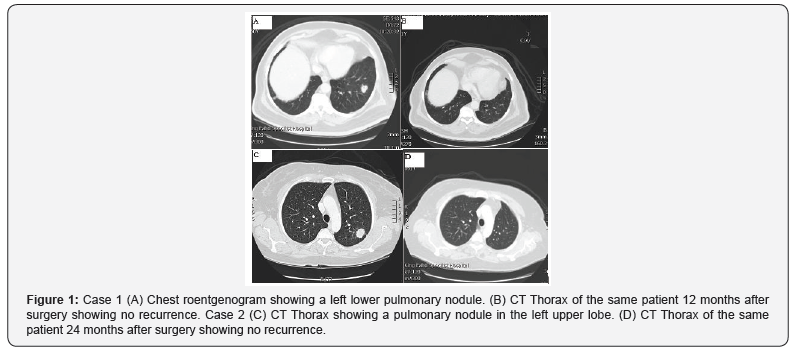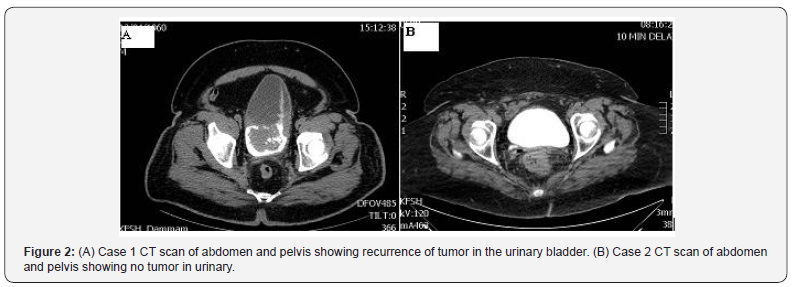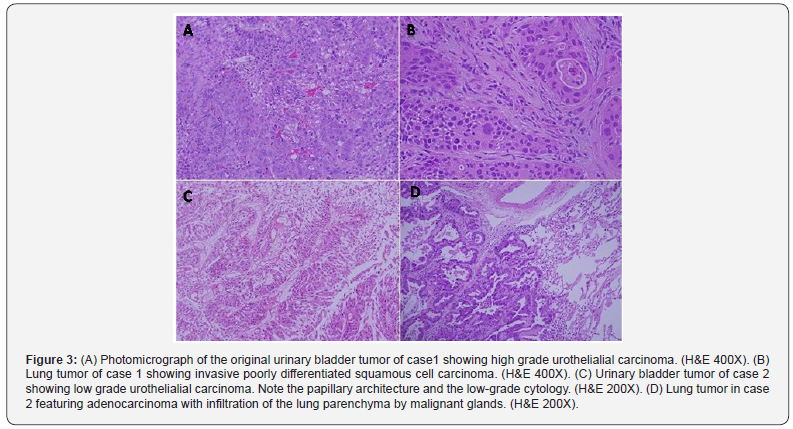Carcinoma of Urinary Bladder and Subsequent Carcinoma of Lung: Rare Combination of Two Primary Carcinomas with Different Histopathology-Juniper publishers
JUNIPER PUBLISHERS-OPEN ACCESS INTERNATIONAL JOURNAL OF PULMONARY & RESPIRATORY SCIENCES
Abstract
These days multiple malignancies are encountered more
frequently because of early diagnosis and recent advances in
Chemotherapy /Radiotherapy, leading to prolonged survival with potential
of developing a new malignancy. Transitional cell carcinoma of urinary
bladder with subsequent development of carcinoma of lung is exceedingly
rare. We report two cases of urinary bladder carcinoma with latter
development of primary lung carcinoma.
Introduction
Transitional cell carcinoma of urinary bladder is the
most common malignant neoplasm of the urinary tract. Globally the
incidence of urinary bladder cancer is 10.1% and 2.5% per 100,000 in
male and female respectively. The urinary bladder cancer that is
confined to mucosa (stage Ta+ carcinoma insitu) and limited to lamina
propria (T1) [1] are grouped together as non – muscle invasive bladder
tumors (NIMBC). The overall incidence of the patients who harbor NIMBC
IS 75-85%. With recent advances in chemotherapy /Radiotherapy and early
diagnostic tools the survival rate has markedly increased in patients
with urinary bladder cancer but on the other hand incidence of second
primary cancer has increased by 16% according to NIC surveillance [2].
For non-muscle invasive bladder cancer, the probability of recurrence at
5 years ranges from 31% to 78% whereas the risk of distant metastasis
is extremely low. We present two cases of urinary bladder cancer that
subsequently developed pulmonary nodule suspected to be metastasis.
Perioperative frozen section revealed primary lung cancer.
Case 1
A 50 years old male smoker, diabetic known hypertensive
presented in 2009 with painless hematuria flexible urinary
bladder examination revealed a bladder tumor. He underwent
transurethral resection of bladder tumor (TURBT), histophalogy
report showed superficial bladder cancer. He was initially treated
with intravesical Bacilli Calmette Guerin therapy (BCG) follow
up check cystoscopy revealed a recurrence of tumor which was
treated with surgical resection and intravesical installation of
mytomycin and BCG and systemic chemotherapy (Gemcitabine
and Cisplatin). Further follow cystoscopic examination showed
residual disease and biopsy report revealed residual high grade
urothelialial carcinoma with no muscle invasion. CT scan of
chest performed in 2012 showed left lung nodule in lower lobe
suspecting metastasis (Figure 1). The lesion was approached
through left postero lateral mini thoracotomy and biopsy
was taken for frozen section. Histopathology report revealed
primary squamous cell carcinoma of lung, based on this plan was
changed from metastatectomy to left lower lobectomy. Patient
post-operative recovery was uneventful and follows up CT scan
of thorax after two years showed no recurrence.

Case 2
A lady age 60 years was diagnosed in 2001 with superficial
transitional cell carcinoma of urinary bladder. She was treated
with TURBT and later on intravesical installation of BCG.
Surveillance cystoscopic examinations were normal. In 2011 CT
scan of chest showed a nodule in left lung upper lobe (Figure
2). Patent underwent left mini thoracotomy and frozen section
biopsy showed primary adenocarcinoma of lung, therefor left
upper lobectomy was performed. Her post-operative recovery
was uneventful and to date she is disease free according to
yearly CT scans of chest report.

Discussion
The Urinary bladder cancer is more common in smokers
and in those who are exposed to Aromatic amines (paint, iron,
aluminum printing, tar and gas industries) [3]. The development
of second primary cancer is multifactorial either the genetic
mutation, treatment related or smoking as shared etiology in
urinary bladder and lung cancer. Incidence if lung cancer in
smokers is 20-40 folds higher in comparison to nonsmokers.
Ninety percent of patients with lung are smokers while 20
% of smokers develop lung cancer [4,5]. On the other hand,
the incidence of urinary bladder cancer is directly related to
duration and number of cigarette packs consumption. Two out
of three patients with urinary bladder cancer are smoker. Livi &
Germic et al. [6] reported that incidence of two primary cancers
in smokers is 10-20% [6]. Certain urological surgical procedures
such as uretro sigmoidostomy may induce second primary
neoplasm [7].
The superficial urinary bladder cancer rarely progress to
invasive or metastatic stage. The FINNISH cancer registry data
reported by L Teppo et al. [8] showed in 1300 second primary
cancer in 77548 lung cancer patients and among them there were
140 cases of urinary bladder cancer [8]. The diagnosis of urinary
bladder cancer is based on several factors, including patients’
presenting symptoms, urine examination and radiological
imaging modalities. The most common presenting symptoms
are hematuria, but less frequently may also include increased
urinary frequency, dysuria and bladder outlet obstruction. Urine
cytology is can be positive for malignant cells in high grade
tumors and in carcinoma in situ, but is usually negative in low
grade tumors. Imaging modalities most commonly employed
to reach the diagnosis are urinary tract ultrasound scan and CT
scan of abdomen and pelvis.
Preoperative work up and correct diagnosis and staging
work up is essential for planning appropriate treatment, better
prognosis and long term survival. Although the survival of
patients depends time interval between two primaries and
histological type and grading superficial urinary bladder cancer
normally don’t progress to invasive or metastatic stage despite
of that it is most common malignancy of urogenital system.
A few cases of superficial bladder cancer with pulmonary
metastasis has been reported in medical literature [9]. It is
exceedingly rare that subsequent to urinary bladder cancer
patient develop primary lung cancer. M Vainrib & Leiobovtich et
al. [10] reported retrospective analysis of 25 patients between 1990 to 2005 who were diagnosed with dual malignancy urinary
bladder cancer and lung cancer, they found that in 84% of cases
the bladder was first primary tumor site and in 60 % of case it
was second primary tumor site [10]. The cases we report here
both were diagnosed radiological as metastasis, but we decided
to perform frozen section to confirm diagnosis. This changed
our management plan. A full histopathology report revealed two
different cancers (Figure 3A-3D).

Conclusion
In conclusion Carcinoma of Urinary Bladder and Subsequent
Carcinoma of Lung is very rare combination of two Primary
Carcinomas with different Histopathology. A frozen section
biopsy is very useful in such case because this will not only help
for appropriate surgical procedure such as metastatectomy or
lung lobectomy but also has great impact on prognosis and longterm
survival of patient. Therefore, we strongly recommend the
use of frozen section in such cases.
To know more about Open Access International
Journal of Pulmonary & Respiratory Sciences please click on: https://juniperpublishers.com/ijoprs/index.php
To know more about Open access Journals
Publishers please click on : Juniper Publishers
To know more about juniper publishers: https://juniperpublishers.business.site/
Comments
Post a Comment